
- Authors: Poland, Brezzin Institute of Breeding
- Repairability: Yes
- Berry color: bright red
- Taste: sweet
- Ripening period: late
- Berry weight, g: 5-6
- Yield: 4 kg per bush
- Drop off location: no low or high ground, away from groundwater
- Fruiting period: from August to frost
- Keeping quality: Yes
Gardeners and farmers who grow raspberries on their land are always looking for new varieties of berries that are maximally resistant to weather disasters and give high yields. One of these is the Polish raspberry variety Delniva, which has already been successfully tried by many summer residents.
Breeding history of the variety
Delniva is a fairly new, still poorly studied, but very tasty berry variety. It was bred by Polish breeders less than 10 years ago. The parental roots of this species are the varieties Polka, Polana, Heritage and Tulamin, from which the new type of plant has taken all the best and most useful.
Description of the variety
The plant is a medium-sized bushes with thickened stems covered with sharp thorns. The height of the bush does not exceed 1.5 meters, it does not need to be tied up, supports should be built, and the berries are placed above the leaves, which greatly simplifies the harvesting process.
Ripening terms
The ripening period begins at the end of summer and ends with the arrival of the first frost, with a yield of more than 90%. This variety belongs to the later, however, compared to such species as Polka, it is considered an early one. In a greenhouse, such raspberries bear fruit until the end of November.
Growing regions
This variety is quite resistant to weather fluctuations and multiple diseases, so it can be grown in the middle zone of the country, in the south, in Siberia, the main thing is to comply with all terms, planting and care rules.
Yield
The yields of this raspberry are very high. You can count on the harvest from the first year of planting. On average, up to 4 kg of berries can be harvested from each bush, which is perfectly stored and transported, which is important when raspberries are grown on an industrial scale. The berries are easily removed, but do not crumble or darken.
Berries and their taste
Raspberry Delniva is characterized by large cone-shaped berries with a dense and juicy texture that is resistant to deformation. The color of the fruit is bright red, and the aroma is rich. The weight of each berry reaches 6 grams.

Growing features
Compact raspberry bushes do not require huge plots of land, do not need the construction of trellises, they have excellent shoot-forming ability, but they have their own growing characteristics.
Site selection and soil preparation
Planting occurs in spring or autumn. Before this, the site is carefully prepared - the weed is removed, the soil is dug up, and it is also moistened. The best soil is loam and chernozem with neutral or low acidity. The best place will be an area that is well lit by the sun, where there are no strong winds and drafts. The fence will be the protection from the wind. A shaded area can lead to stunted growth and reduced yields. In addition, this species does not like lowlands and hills.In one place, the plant is able to grow and give good yields for 8-10 years.


Pruning
The stems are shortened after full harvest, that is, in late autumn. Previously, it is not recommended to do this, since it takes time for the outflow of nutrients into the root system, which is the basis for preparing the plant for the next season of development and fruiting.

Watering and feeding
Watering should be carried out after planting, during flowering and ripening of fruits, as well as during dry periods. The plant has a very high demand for feeding. Replenishment occurs before planting, and then during the period of growth and fruiting. It is not recommended to use nitrogen-containing fertilizers that prevent the plant from rooting.


Frost resistance and preparation for winter
The plant is very resistant to frost, however, after shortening, it is recommended to drop the stems slightly.

Diseases and pests
Polish raspberries have a high immunity to diseases and pests. It is resistant to spider mites and gray rot, but preventive measures should be taken. As a preventive measure, spraying with special solutions is used.

Unfortunately, raspberries, like other plants, do not bypass various diseases and pests. Only armed with the knowledge and the necessary means for this, you can cope with such troubles. To help the plant, it is very important to be able to recognize the disease in time and begin timely treatment.
Reproduction
The plant multiplies rapidly with suckers, which are sufficient for rapid breeding of the variety. Before planting, the roots are dipped in a special clay solution.You can plant the bushes individually or in a row, keeping a distance of 1 meter from each other.

Review overview
Despite the fact that the variety is quite new and poorly studied, gardeners and farmers willingly grow it, since raspberries are very sweet, aromatic and healthy. Many farmers note unpretentious care, compact planting and high yields, even with frequent winds and rains.
Amateur gardeners characterize this type of plant as completely not capricious, rapidly growing, fruiting, the main thing is to feed it with useful fertilizers in a timely manner. Among the disadvantages is the high cost of seedlings.







































































